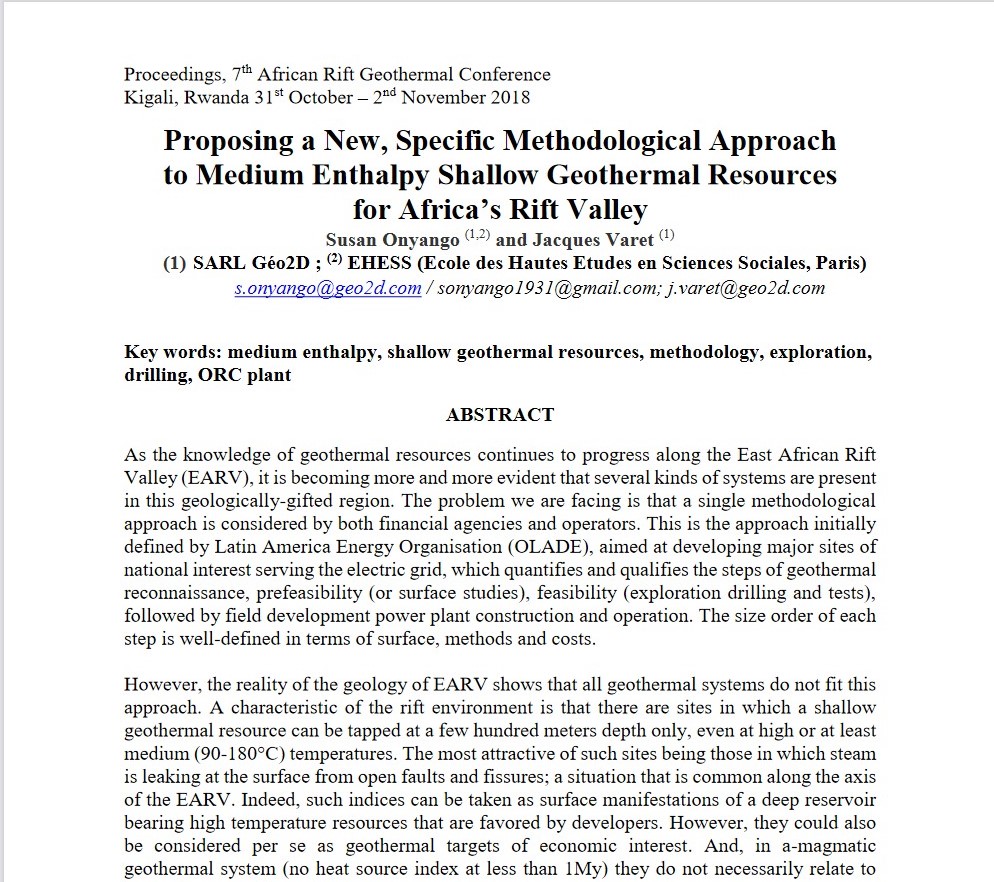Proposing a New, Specific Methodological Approach to Medium Enthalpy Shallow Geothermal Resources for Africa's Rift Valley
 |
Proposer une nouvelle approche méthodologique spécifique aux ressources géothermiques à enthalpie moyenne pour la vallée du Rift en Afrique
article Nov 2018 ; 15 pages
Aut. Susan Onyango & Jacques Varet
Ed. ARGeo - Nairobi
Téléchargeable chez l'éditeur
Page de présentation d'un éditeur
Abstract:
As the knowledge of geothermal resources continues to progress along the East African Rift Valley (EARV), it is becoming more and more evident that several kinds of systems are present in this geologically-gifted region. The problem we are facing is that a single methodological approach is considered by both financial agencies and operators. This is the approach initially defined by Latin America Energy Organisation (OLADE), aimed at developing major sites of national interest serving the electric grid, which quantifies and qualifies the steps of geothermal reconnaissance, prefeasibility (or surface studies), feasibility (exploration drilling and tests), followed by field development power plant construction and operation. The size order of each step is well-defined in terms of surface, methods and costs. However, the reality of the geology of EARV shows that all geothermal systems do not fit this approach. A characteristic of the rift environment is that there are sites in which a shallow geothermal resource can be tapped at a few hundred meters depth only, even at high or at least medium (90-180°C) temperatures. The most attractive of such sites being those in which steam is leaking at the surface from open faults and fissures; a situation that is common along the axis of the EARV. Indeed, such indices can be taken as surface manifestations of a deep reservoir bearing high temperature resources that are favored by developers. However, they could also be considered per se as geothermal targets of economic interest. And, in a-magmatic geothermal system (no heat source index at less than 1My) they do not necessarily relate to large deeper geothermal resources. Schematically, one can distinguish two kinds of geological contexts: “Central” volcanic units in which a caldera, and/or a set of silicic domes less than 1My old, reflect the presence of a shallow magma chamber and high temperature heat source, that are suitable for large-size (up to over 100 MWe) geothermal development serving the national grid. For such systems the above-mentioned and presently dominating classical approach is pertinent. Faultand or dyke-controlled systems allowing mediumto high temperature convective fluids to percolate to the surface. In such systems, the size of the resource is definitively not the same (between 100 kWe and 10 MWe), and the exploration, development methodology as well as the tools should differ and adjust according to both the geological target and cost-efficiency. Inevitably, the geothermal developments here should also directly rely upon the social demand on site. While underlining the need for such a new, different and specific approach to be implemented through existing entities like African Rift Geothermal (ARGeo), Geothermal Risk Mitigation
Publics-Cibles:
Mot clef: |
Pays concerné: |
Editeur/Diffuseur: |
|
ARGeo
-
The African Rift Geothermal Development Facility - ARGeo - Nairobi - Kenya |
En cas de lien brisé, nous le mentionner à communication@pseau.org